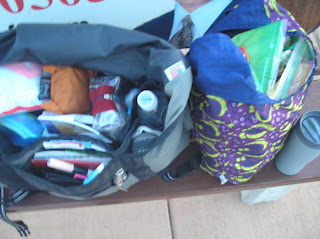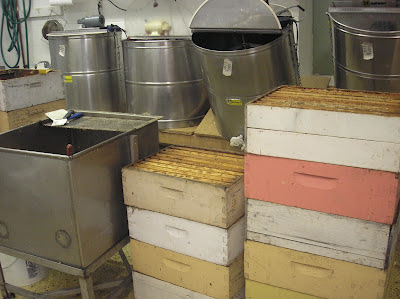Almost every day is different for me so picking a day to do is a no brainer, a day I go work at the bee farm. Apiary, beekeeper, honey-maker. Any way you put it, it's my favorite job.
5:30 am: Wake up and wash my face, dress, finish packing my clothes in to a cinch bag & food into a bag for the weekend make some coffee and grab some breakfast. During this summer I travel to the farm and stay there for the next 3-4 days because it's a 45 minute to an hour long commute. It's much simpler to stay and I can put in 10-12 hour days.
 |
| Oak grove I walk by on my way to the bus stop |
6:10 am: Catch the bus a block away from my house to downtown Minneapolis where I transfer buses to a park and ride where my lovely co-worker picks me up and takes me with her to the farm.
 |
| The amount of stuff I bring with me. Left is an "overnight" bag while the right is some food :) |
8 am: Arrive at work, say hi to everyone, turn the radio on to mpr and start cleaning. This might sound backwards, but I've been extracting honey (don't worry I will explain this more through out the post) this summer and only one doing it for the most part. So I need to clean the dripping wax that is now dry, pull melted wax from water baths, wash empty honey buckets that have been returned from clients so forth and so on. Work is never ending here, which is a good thing.
 |
| Extractors in the back (large silver drums), extracting stand (square silver thing) and stacks of honey supers (squared colored boxes) |
9 am: Cleaning is done. Start to stock my room (yes I have a whole room to myself mostly) with supers of honey and clean empty pails, grab needed tools and start extracting honey. Work until I need a break or need more of something.
Overall Extracting Process:
 |
| Starts with capped honey in frames which are in bottom-less boxes called supers (see above:1 frame from a super) |
 |
| Uncap the wax on the cells exposing the honey on each frame using an extracting comb, put 9-10 in the large extractor and let the centrifuge pull honey from the comb |
 | | | |
| Empty frame of comb after being extracted |
|
 |
| Open spicket on extractor and let honey run through a double filter into food safe pail and you have honey to bottle |
So I do this process over and over during a 10-12 hour day over the course of 3-4 days during this summer. On my best day I go through 26 boxes/supers of honey and with each of those supers weighing 40ish lbs, I move a lot of honey.
 |
| Different Frames of Capped Honey |
But with honey and bees being very interesting (at least to me) there are very interesting things you see through out the day. Such as the differences of wax and honey colors. Above shows how the wax capping the honey can be of very different colors. This being due to how much the bees walk on it or the amount of time the honey is left on the hive. In this case the newest being the whitest and the darkest being the oldest.
 |
| Detail of the wax capping on the honey |
The wax also has very interesting shapes, contours and feelings. We use 9 frames in most supers giving the bees a little more space to work, which can also make for some unusual frames as they will fill space as they need it and a simple frame can be attached to another or a few making my job more interesting trying to save as much honey as possible.
 |
| Detail of looking through honey in light colored comb |
But with a few bees flying around and the radio on I can make pretty quick work of it all. Tasting honey, looking at all the colors that are made from the different plant sources the bees take nectar from making honey, seeing their wondering construction of comb and the amazingness of it all.
 |
| Left: Lit smoker while working hives, Center: Melon Farm where we have some of our hives, Right: Female worker bee, I usually have one on me during the day |
Needless to say, I don't just extract honey. Any given day, I could be helping work the bees with Dan, our master beekeeper; out picking apples in one of the many orchards, helping bottle, label or get orders ready for the farmers market, help anyone else around the honey house do what they do, which is almost everything. We all do almost everything here. Which is nice especially when everything needs to be done all the time.
 |
| Left: Freshly picked Honey Crisp apples, Center:Beeswax Candles, Right: One of our stands at the farmer's market |
Strangely, I always bring my camera to work with me. Most of these pictures have been captured over the 3 years I have worked at the farm and usually try and snap some pictures when I see something new or was learning the trade.
 |
| Left: Owner Brian holding up a frame, Center:Apples still on in the orchard, Right:Beehive in the front yard in the shade |
I could literally go on for hours about bees, honey and anything that goes with it. By the end of the day I usually smell a mix of sweat and honey (which isn't a bad combination). I grab something to eat (I usually snack all day), shower (so I get all the odd sticky spots off my arms) and read until I am to tired to anymore and do it all over again for a few days a week.
I hope to work bees when I'm in Senegal and CANNOT wait do to that.And hope to show some of the differences and similarities in that process there.
Any questions??? Feel free to ask!






Thanks for sharing what one of your days looks like - this was very interesting. I can't wait to see one of these Days in the Life when you get settled in Senegal.
ReplyDelete